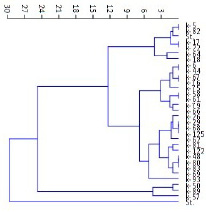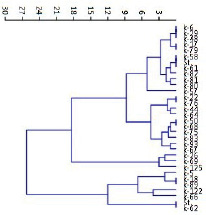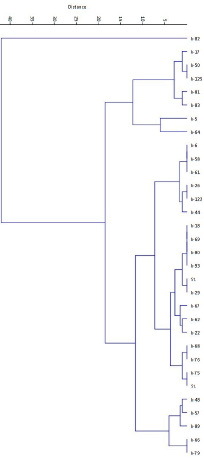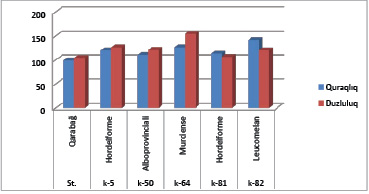Stress factors is a symptom that is accepted as a source that reduces the normal development of plants. These symptoms include drought, salinity, high and low temperatures, and so on. Abiotic stresses cause changes in the physiological activity of plants, weaken the process of biosynthesis in cells, disrupt the normal functioning of plants. Therefore, the creation of new plant varieties and forms that are more productive and resistant to stress factors using plant genotypes resistant to various stresses, including drought, heat and salinity, which can be grown in unfavorable climatic conditions, is an urgent problem.
Azerbaijan is a place with a rich variety of soft, hard wheat and rye. This diversity requires research on genetics, selection, evolution, and plant origin. Being part of the South Caucasus, Azerbaijan is considered one of the primary centers of wheat origin.
Durum wheat is mainly distributed in hot and dry areas. Durum wheat loves moisture during ripening, despite the high temperature and drought. It has been collected and confirmed as a result of expeditions that it is widespread in all mountainous and foothill areas of Azerbaijan and has a great diversity [1]. Because each variety has the power to affect certain abiotic stresses, the balance in metabolic processes is disturbed after that effect. The persistent variety quickly eliminates the changes in metabolic processes under the influence of extreme factors.
Thus, it is recommended to select stress-resistant samples and use them in breeding. Resistance to these factors is determined by various mechanisms. the changes in expression of stress genes regulates these mechanisms.
At present, the Genetic Resources Institute of the ANAS carries out a number of research on the issues as the collection and increase the variety and diversity of wheat, the conservation of biodiversity of the gene pool. Biomorphological and economic features of 2158 wheat genotypes are studied particularly. Their biotic and abiotic stress factors tolerance is determined, and the use of genotypes with effective properties in breeding is recommended [2,3,4]. The research conducted by us is a part of the solution to this issue.
Materials and methods of research
The research was held on 31 of 18 durum wheat (T. durum Desf) varieties.
The purpose of the study is to investigate the relationship between the tolerance of wheat genotypes to salinity and drought stresses and chlorophyll content, leaf samples (the leaf (second) from the top) were exposed to salt and drought stress. For this purpose, the leaves were cut into small circles and divided into three parts. In each experiment, 5 circles were placed into the test tubes. Water was added to the first part, 2% NaCl solution to the other, a sugar solution with a pressure of 20 atm to the third part and kept at 240C for a day. Then the circles were removed from the solution, dried with filter paper, transferred to a 10 ml test tube, added alcohol, and boiled for a few minutes (until the circles turned white).
After cooling, the volume of alcohol was increased to 10 ml in the test tube and a spectrophotometer was used to measure the chlorophyll content, chlorophyll “a” was on the wavelength of 665 nm, and chlorophyll “b” of 649 nm. The ratio of pigment concentration to the water condition was detected and this correlation was accepted as a criterion for the selection of forms with salinity and drought resistance. According to the level of the results, the sample will be considered the more resistant. [5] In addition, the physical features of the seeds – the amount of gluten, sedimentation, and quality, sedimentation sediment were determined [6]. Vitrescence of grain, 1000seeds weight was studied by the accepted methods (DS-10842-64, 10840-64), based on the amount and quality of gluten (DC-9406-60), the quality of gluten, flour resistance, and dough stretching was assessed (resistance was measured by the GDI-1 device). The sediment indicator was determined with acetic acid based on macro method [7].
Results of the research and discussions
The results of the research in Table 1 show the chlorophyll “a”, “b”, the sum of “a” and “b”, the ratio of “a” to “b” in the leaves of wheat varieties exposed to drought and salt stress.
Pigments are involved in the process of photosynthesis in the transferring of oxygen, oxidative and photosynthetic phosphorylation, in short, in the general metabolism of plants. Chlorophylls (especially chlorophyll “b”) are of great importance in the plant’s adaptation to unfavourable environmental factors. During adaptation, a slight decrease or increase in the ratio of chlorophyll “a” to “b” is seriously reflected in the physiological processes occured the plant.
The effect of stress factors on the amount of chlorophyll is reflected in the intensity of photosynthesis. Changes in the chlorophyllcontent of the leaves due to drought and salinity stress are also reflected in our research. In addition to the impact on the physiological status of plants, salinity and drought stress, significantly affect the normal course of photosynthesis. O.V. Udovenko notes that the amount of green pigments decreases in a saturated chloride environment. Decreases of chlorophyll content due to salinity and drought stress are associated in some cases with a decrease in their volume as a result of the destruction of chloroplasts. It is believed that this situation leads to a decrease in the intensity of photosynthesis. It is also noted that in plants that are not resistant to salinity, more chloroplasts are destroyed and the intensity of photosynthesis is reduced. It was found that changes in the plastid system of wheat plants intensify with increasing salt stress [8].
Using these factors, they can be used as initial material in the breeding, as well as in the evaluation of new hybrids, lines, and varieties, and in the detection of promising crop varieties [9,10].
Based on the indicators of chlorophyll “a + b” in Table 1, the selected 6 drought-resistant samples and 8 salinity tolerant accessions were indicated by the (-)in the table.
Changes in the pigment system occur mainly due to the labile-bound chlorophyll «a», chlorophyll «b» is more stable, less variable, and this is due to the fact that the binding energy of water molecules in chlorophyll «b» is stronger than in chlorophyll «a».
To sum up the results, the samples were grouped in a dendrogram according to the changes that occured in chlorophyll content (a + b) due to drought and salinity conditions (Figure 1, 2). The samples in the dendrogram are classified into two groups: the first group includes tolerant samples (high percentage of controls) and the second group includes samples with less than 90% according to control. The chlorophyll content of these samples decreased due to drought and salinity stresses. These samples are accessed as drought and salt-sensitive varieties due to changes in chlorophyll (a + b) content.

Fig. 1. Grouping of samples according to the chlorophyll content (a + b) due to the drought impact
Table 1
Indicators of tolerance to drought and salinity due to changes in chlorophyll content of the durum wheat leaves (T. durum Desf.)
|
Catalog №- |
Sample name |
Chlorophyll content (in Mcg in a single leaf area) |
Ca+Cb və Ca/Cb parameters (control %) |
|||||||||
|
Control |
Dr/stress |
Sal.stress |
Dr. |
Sal. |
||||||||
|
a |
b |
a |
b |
a |
b |
a+b |
a/b |
a+b |
a/b |
|||
|
1 |
2 |
3 |
4 |
5 |
6 |
7 |
8 |
9 |
10 |
11 |
12 |
|
|
St. |
Garabagh |
6,09 |
1,93 |
2,08 |
2,00 |
6,58 |
2,00 |
107- |
99≡ |
106= |
104= |
|
|
St. |
Barakatli |
3,45 |
1,01 |
4,28 |
1,31 |
4,70 |
1,39 |
125- |
95≡ |
136- |
99= |
|
|
k-5 |
hordeiforme |
3,85 |
1,67 |
4,38 |
1,59 |
5,26 |
1,81 |
108- |
120- |
128- |
126- |
|
|
k-6 |
hordeiforme |
8,06 |
3,23 |
7,96 |
3,04 |
8,83 |
3,46 |
97≡ |
104- |
108= |
102= |
|
|
k-17 |
murciense |
3,90 |
1,50 |
4,37 |
1,53 |
4,41 |
1,46 |
109- |
109- |
109= |
116- |
|
|
k-18 |
mutico Murciense |
7,52 |
2,55 |
6,31 |
2,07 |
8,91 |
2,61 |
105= |
96= |
126- |
86≡ |
|
|
k-22 |
hordeiforme |
6,76 |
1,91 |
6,26 |
1,66 |
6,81 |
1,65 |
109- |
94= |
102= |
86≡ |
|
|
k-26 |
melanopus |
6,42 |
2,28 |
6,22 |
2,15 |
5,31 |
1,93 |
95≡ |
102= |
83≡ |
97≡ |
|
|
k-29 |
coerulescens |
5,61 |
2,32 |
5,25 |
2,28 |
6,18 |
2,45 |
94≡ |
95= |
108= |
104= |
|
|
k-44 |
albo Obscurum |
5,30 |
2,24 |
5,23 |
2,14 |
5,62 |
1,93 |
97≡ |
103= |
100= |
123- |
|
|
k-48 |
alboprovinciale |
5,28 |
1,66 |
4,63 |
1,73 |
5,54 |
1,98 |
91≡ |
84≡ |
108= |
88= |
|
|
k-50 |
alboprovinciale |
4,09 |
1,57 |
3,00 |
1,04 |
4,14 |
1,31 |
71≡ |
110- |
96≡ |
121- |
|
|
k-57 |
lybicum |
3,63 |
1,15 |
2,72 |
0,91 |
4,08 |
1,27 |
76≡ |
85≡ |
112- |
102= |
|
|
k-58 |
lybicum |
8,29 |
2,91 |
8,38 |
2,83 |
8,74 |
3,14 |
101= |
104- |
106= |
89= |
|
|
k-61 |
hordeiforme |
5,54 |
2,58 |
5,33 |
2,47 |
5,53 |
2,12 |
96= |
100= |
94= |
121- |
|
|
k-62 |
affine |
4,09 |
1,57 |
3,73 |
1,54 |
5,66 |
2,06 |
93≡ |
93= |
136- |
105- |
|
|
k-64 |
murciense |
3,08 |
1,77 |
4,07 |
1,17 |
3,92 |
1,45 |
103= |
126- |
101= |
154- |
|
|
k-66 |
murciense |
7,20 |
2,73 |
6,97 |
2,97 |
8,56 |
3,56 |
100= |
89≡ |
122- |
91≡ |
|
|
k-67 |
apulicum |
4,34 |
1,09 |
4,19 |
1,14 |
4,27 |
1,10 |
98≡ |
92= |
99= |
97≡ |
|
|
k-68 |
leucomelan |
5,77 |
1,75 |
5,42 |
1,67 |
5,61 |
1.64 |
94≡ |
98= |
96= |
103= |
|
|
k-69 |
melanopus |
4,05 |
1,66 |
3,70 |
1,58 |
3.35 |
1,55 |
92≡ |
96= |
85≡ |
88≡ |
|
|
k-75 |
murciense |
4,59 |
1,24 |
4,40 |
1,20 |
4,53 |
1.12 |
96= |
99= |
97= |
109- |
|
|
k-76 |
melanopus |
5,23 |
1,63 |
5,10 |
1,62 |
5,56 |
1,44 |
98= |
98= |
102= |
120- |
|
|
k-79 |
leucomelan |
4,17 |
1,27 |
4,02 |
1,36 |
4,61 |
1,33 |
99= |
89≡ |
109- |
105= |
|
|
k-80 |
apulicum |
4,61 |
1,65 |
4,16 |
1,55 |
4,93 |
1,67 |
91= |
96= |
105= |
105= |
|
|
k-81 |
hordeiforme |
7,27 |
2,82 |
6,70 |
2,30 |
7,71 |
2,80 |
89≡ |
113- |
104= |
106= |
|
|
k-82 |
leucomelan |
3,16 |
0,96 |
2,89 |
0,23 |
3,65 |
0,78 |
108- |
142- |
107= |
120- |
|
|
k-83 |
aegiptiacum |
4,28 |
1,17 |
4,01 |
0,98 |
3,82 |
1,39 |
91= |
112- |
95= |
75= |
|
|
k-89 |
mut.Africanum |
5,48 |
2,07 |
4,14 |
2,06 |
7,25 |
2,28 |
72≡ |
86≡ |
126- |
120- |
|
|
k-93 |
hordeiforme |
4,27 |
1,54 |
3,69 |
1,38 |
4,18 |
1,52 |
87≡ |
96= |
98= |
99= |
|
|
k-122 |
niloticum |
4,85 |
1,73 |
4,42 |
1,54 |
5,76 |
2,00 |
90= |
102= |
118- |
103= |
|
|
k-125 |
affine |
6,53 |
2,30 |
6,34 |
2,02 |
5,20 |
2,53 |
94= |
110- |
87≡ |
72≡ |
|
Symbols: – tolerant . = moderate tolerant. ≡ not tolerant

Fig. 2. Grouping of samples according to the amount of chlorophyll (a + b) under the impact of salt stress
Among the selected varieties, Standard Karabakh and Standard Barakatli, v.hordeiforme in the K-5 catalog listed in the table for their high photochemical activity of chloroplasts can be shown; The chlorophyll “a” was 3.85 Mk-grams in the control variant, and 4.38 Mk-grams under the drought stress, and 5.26 Mk-grams under the salt stress. The parameters of chlorophyll “b”: in the control was 1.67, under the drought 1.59, and under the salt stress 1.81 Mk-gr. Based on the results, the percentage of chlorophyll (a + b) in this accession was 108 (in the control variant) and 128 under the salt stress, and this sample was selected as a tolerant sample due to the high photochemical activity of the leaves.
In Figure 3, the samples are grouped according to their drought resistance. The dendrogram shows close samples in terms of durability. The chlorophyll a / b ratio in the leaves of the samples exposed to the drought stress located in the upper group was 100-142% and were evaluated as resistant (K-82, 17, 50, 125, 81, 83, 5, 64, 6, 58, 61, 26, 122). 44) after stress, the chlorophyll a / b in the leaves of samples located in the subgroup was 86-96% according to control. These samples were assessed as susceptible to drought.
The high ratio of chlorophyll «a» to «b» in 5 samples after quarrying and salt stress in 5 samples: v in the catalog K-5. hordeiforme; In the K-50 v. alboprovinciale; V.mürciense in K-64; In K-81 v. hordeiforme; In K-82 v. was in leucomelanda. Thus, the samples shown were selected to be resistant to both stresses (drought, salt) (Table 1, Figure 4).

Fig. 3. Grouping of samples according to the chlorophyll a / b content due to drought stress impact
These accessions are with a more active pigment complex than others. The content of the photosynthetic pigment is high (Table 1). Therefore, these samples have a very active photosynthetic apparatus, and the process of converting light energy into chemical energy (ATF and HADF forms) is more intensive.
Quality wheat must first have a high protein, gluten, and sedimentation index. Physical parameters, quantity and quality of gluten, and sedimentation sediment were determined in the grains of the samples. The results obtained for vitrescence and the 1000seeds weight were satisfactory.

Fig. 4. The samples with resistance to both stresses (drought, salinity)
Table 2
The samples selected from local and introduced durum wheat varieties for their high parameters
|
Catalogue № |
Sample name |
Physical parameters |
Amount and quality of gluten |
||||
|
vitrescence |
1000 seed weight |
Extensibility cm |
Amount %-lə |
GDI |
Sedmentaiıon ml |
||
|
St |
Garabagh |
92 |
53,2 |
8 |
31,0 |
95 |
10,3 |
|
St |
Barakatli |
51 |
50,8 |
6 |
25,6 |
95 |
8,0 |
|
5 |
v.hordeiforme |
100 |
44,0 |
6 |
42,5 |
85 |
14,6 |
|
62 |
v. affine |
90 |
57,6 |
8 |
31,8 |
95 |
12,1 |
|
64 |
v. murciense |
85 |
57,2 |
10 |
30,0 |
95 |
10,0 |
|
76 |
v. melanopus |
87 |
58,0 |
11 |
33,8 |
100 |
10,2 |
|
83 |
v. aegipteacum |
92 |
57,2 |
9 |
33,5 |
95 |
10,1 |
In 19 of the 31 samples studied, 1000seeds weight was more than 50 g (v. Leucomelan 60.8 g; v. Murciense 58.5 g; v. Hordeiforme 59.6 g, etc.). Vitrescence mainly varied between 77-99%. In 13 samples, the amount of gluten was more than 30% (amount of gluten in v. hordeiforme was 42.5%, GDİ 85; v. affine 36.6%, GDİ 95; v. Mutico murciense 36.6%, GDİ 95, etc. ). Based on the research, genotypes with high physical parameters were selected, and the results of the Karabakh variety taken as a standard are given in Table 2.
In the 31 durum wheat genotypes, 14 specimens had high gluten content (above 30%).
19 samples (v. Leucomelan 60.8 g; v. Hordeiforme 59.6 g) were selected from the quantitative indicators of grain according to the 1000 seed weight. The characteristics of the studied wheat genotypes are included in breeding programs to help breeders achieve high yields.
Also, based on the changes in the plastid apparatus of the leaves, from the studied durum wheat samples Standard Karabakh; In the K-5 catalog v. hordeiforme; In the K-50 v. alboprovinciale; V.mürciense in K-64; In K-81 v. hordeiforme; In K-82 v. leucomelan it was determined that they are resistant to both stresses (drought, salt) and can be used as donors in breeding processes.

